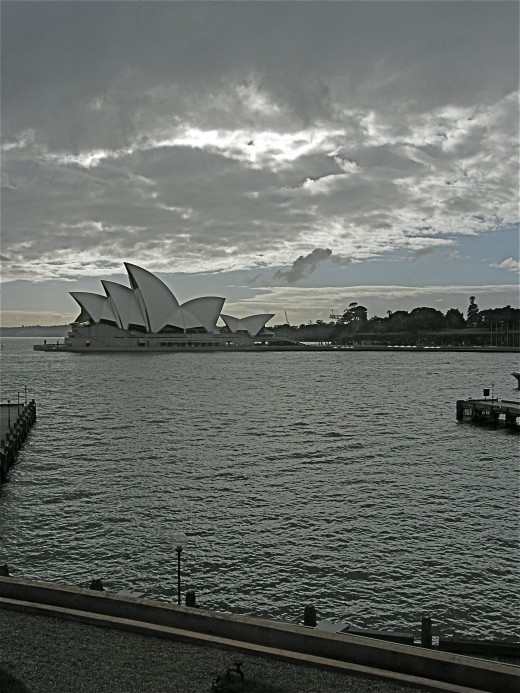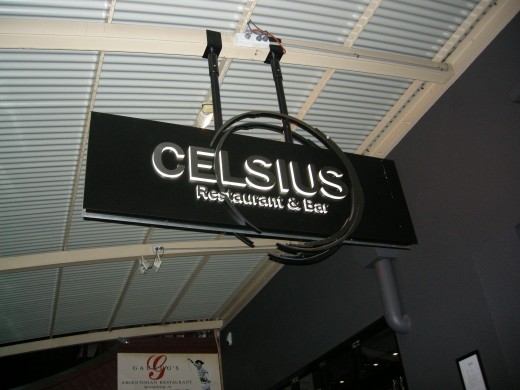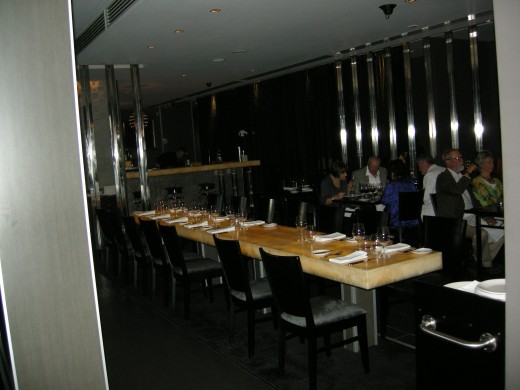NOTES FROM DOWN UNDER: In Search of Australian Gastronomy

Having lived twice in London–and traveling a great deal as well, I’ve made a menagerie of Australian friends through the years, and seeing them all again was the main reason I’d been looking forward to my first trip Down Under. Friendship to one side, however, I was also keen to sample the country’s storied gastronomy, since Australian chefs have displaced European ones all over Asia, Australian food photographers and stylists are second to none, and one of the world’s two or three best mass-market food magazines is published in Australia, too–The Australian Gourmet Traveller (America should be lucky enough to have a magazine of this sophistication, wit and originality, instead of all of those food books that are 15-minutes-to-dinner recipe driven, advertiser tethered, or fumbling to find the surely lucrative cross-hatching between food and celebrity {If the economy improves a bit more next year, I wouldn’t be remotely surprised to come across PEOPLE–FOOD! on the newsstand}). So numb to dumb with fatigue, I arrived in Sydney a few weeks ago, and couldn’t wait to sink my fangs into a full-house of Antipodean menus.
My first meal in Sydney was at Aria, a high-polish place that talented chef Matt Moran opened in 1999 and which has beautiful views over the Sydney Opera House with a rumored rent of $800,000 a year. I mention the rent, because it would seem to have a very major impact on the personality of this place. To wit, this restaurant takes itself very seriously, and its staff take themselves very seriously, too–a recurring theme of Australian dining are Euro ex-pat staffers who are perhaps hired to add some allure to the business but who can’t stop themselves from being arch and aloof with other foreigners.
Lunching with Julie, an old friend and an English woman who’d lived in Paris for over twenty years before her Aussie husband decided he wanted to go home, we launched our very happy meal with two brilliant starters–sashimi of yellow fin tuna with shaved fennel and radish, octopus, spicy puffed rice (puffed grains are a regrettably ubiquitous trend in Australia right now) and yuzu purée for Madame, and kurobuta sweet pork belly with pickled watermelon and crackling for me, the highlight here being the delightful acidulated backdrop of the melon against the richness of the fork tender pork with a crunchy crust. Next, steamed fillet of king salmon with braised endive, globe artichokes, calamari and lemon sabayon for me and an ethereally pure dish that was ideal for a jet-lag battered palette and seared fillet of Murray cod, sautéed razor clams with sweet corn,parsley and grilled pancetta for my friend. At her pleading, we drank a lovely Saint Aubin with the meal–accustomed to the viniferous glories of France, she’s already burned out on Aussie wines, many of which are alcohol bombs and few of which approach the subtlety of even moderately priced European wines. Desserts were excellent, too–Savarin with Champagne poached peaches, mascarpone and amaretti biscuit for me, and tempered Manjari chocolate with raspberries, brownie, and cacao ice cream for her. The bill? Nearly $400, and the Aussie dollar is almost at par with the American one.
After lunch we ferried around Sydney harbor, since my friend correctly forbad me to return to my hotel and crash, and I found myself musing on the wallet-busting prices of this very good but not remarkable lunch. There’s a lot of money in Australia right now, and the locals seem to have gone a bit glazed eyed when it comes to local prices, which come as a real shock to anyone who could have scored a similar meal in Paris for about 60 Euros ($85) a head. Aside from the exquisite mostly local produce from which this meal had been prepared, there was nothing about it that struck me as especially Australian, however, and so was born the dining theme of my trip to Oz. What I wanted while I was here was to find real Australian cooking, whatever that might be.
Now at the end of my trip, I’d say Antipodean cuisine is an intriguing if not always harmonious hybrid that’s been born from the country’s incredible food stuffs treated with variously Mediterranean, Asian and, less often, British Victorian techniques, herbs and spices, and flavor spectrums. Lately, the manic molecular cooking of France and Spain has arrived on these shores, along with a brand new fascination with the New Nordic food being done by such dazzlingly good Scandinavian based chefs as Rene Redzepi at Noma in Copenhagen and Frederick Andersson at Mistral in Stockholm. At its best, contemporary Australian cooking is dazzlingly light and bright, with intense flavors and impeccable technique. At other times, it can be rudderless and reductive.
The only places in Australia that I found the sort of regional culinary roots which informs the best American cooking were in Adelaide and the justly fabled Barossa Valley, where the legacy of early immigration to the area from Cornwall is one of the best bakeries I’ve been to in many years, the immaculate and very charming Perrymans, where a friend who grew up locally took me directly from the airport for a quick snack that included the best Cornish pasty–flakey and filled with perfectly seasoned mashed potato with leeks, I’ve ever had, followed by a big German style–Prussians followed the Cornish into South Australia–whipped-cream-filled donut-like pastry. We also bought a raisin-dense tea cake to snack on over the weekend, and it was the best example of this species I’ve eaten in years. In fact notwithstanding the local popularity of its tasty little gingerbread babies, Perrymans is a perfect example of the sort of first-rate high Victorian bakery that used to grace the high streets of all large British towns.
The food in the mostly Prussian settled Barossa Valley was generally excellent, too. I had a very good lunch of Aussie wine-country cooking–smoked salmon with grilled potato terrine and an herb salad and then roast duck with plums and Spring vegetables at 1918 Restaurant in Tanunda, one of the valley’s main wine towns and the home of Penfolds, and a superb dinner at the very mannered Appellation, the restaurant at the Louise, the valley’s best hotel. But aside from a knock-out good bowl of chicken Laksa soup at the Asian dining hall adjacent to Adelaide brilliant main market, the most interesting meal of the trip was at Celsius, a new place in the same South Australian city.

Since I was on my own that night, I decided it would be more fun to take a sidewalk table and watch the crowds on busy Gouger Street than sit inside of the cooly elegant modern dining room–it could easily be used as the setting for a Robert Palmer or Fleetwood Mac video, and settling in, I ordered some deep-fried pork rinds sprinkled with bee pollen to nibble with an excellent glass of Riesling from the Adelaide Hills just outside of the city. The menu was a bit laconic, but Pauline, my absolutely charming waitress, cheerfully commented it through in its entirety–from her pretty accent I suspected she was Italian, but no, it turns out that Pauline is originally from Picardie, so we eventually lapsed into French to our mutual joy, and she helped me construct a perfect meal.
To start, a trio of different tapas-sized appetizers, including scallops grilled in their shells with a delicious, will-copy-this-idea garnish of fresh sweet corn and crumbled bacon; a sublime pod of shredded lamb shoulder with with Moroccan spices, a dollop of tangy fresh yogurt and a superb little salad of flat parsley leaves–a really brilliant little miniature; and an egg that had been poached at a very low temperature for hours with a delicious if rather obvious garnish of crumbled bacon (I’m still waiting for bacon to be identified as a food group in its own right). To be honest, I was frankly startled by the quality of the cooking here. Why? My other big-deal meal in Adelaide at Auge was sort of case study in all that can go wrong with Australian cooking and restaurants–to wit, a wilting tendency to brittle service and over-complicated food with Baroque combinations of flavors and ingredients. So this simple little place launched a few months ago by young chef Ayhan Erkoc and a passionate band of young gastronomes, including his brother, who drives an hour daily to the family’s small organic vegetable farm to collect the produce that adds real drama to the food here, reminded me of outstanding and thrillingly inventive but low key new bistros like Frenchie in Paris. There was that much sincerity, hard work, and culinary intelligence at work here.
 The dining room at Celsius
The dining room at Celsius
My main course, chunks of perfectly roasted duck in a delicate duck bouillon poured a table and garnished with chopped fresh pea shoots, baby radishes, fava beans and dime-sized coin-shaped pieces of zucchini was delightful, especially with the local Mourvedre Pauline suggested, and Erkok’s potato puree puts him into stiff competition with Joel Robuchon for the contender of the world’s best mash.
If Erkoc isn’t yet at the level of a chef like Mark Best, whom I think is the best cook in Australia at his restaurant Marque in Sydney, he’s well on his way to joining the big leagues in country that is passionately interested in not only thrillingly good food, but seriously inventive cooking.




